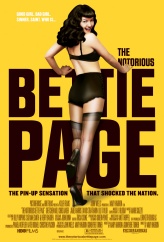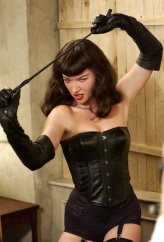| The Notorious Bettie Page |
| |
 |
USA, 2005. Rated R. 91 minutes.
Cast:
Gretchen Mol, Lili Taylor, Chris Bauer, David Strathairn, Jared Harris, Sarah Paulson, Cara Seymour, Norman Reedus
Writers: Mary Harron & Guinevere Turner
Original Music: Mark Suozzo
Cinematography: Mott Hupfel
Producers: Pamela Koffler, Katie Roumel, Christine Vachon
Director: Mary Harron
LINKS
|
 ven if you don't know the name, you've probably seen the photographs, and if you haven't seen the photographs, you at least know the haircut—straight, jet black with square-cut bangs, a popular goth/punk look. Her distinctive hairstyle, her voluptuous figure, and her irrepressibly campy poses served to make Bettie Page the most popular glamour model of the Fifties. By some counts, she was more photographed than Marilyn Monroe. These photos have since been published and re-published, circulated and re-circulated, and even inspired comic books characters. Bettie is a 20th Century icon.
ven if you don't know the name, you've probably seen the photographs, and if you haven't seen the photographs, you at least know the haircut—straight, jet black with square-cut bangs, a popular goth/punk look. Her distinctive hairstyle, her voluptuous figure, and her irrepressibly campy poses served to make Bettie Page the most popular glamour model of the Fifties. By some counts, she was more photographed than Marilyn Monroe. These photos have since been published and re-published, circulated and re-circulated, and even inspired comic books characters. Bettie is a 20th Century icon.
Until recently, Bettie was also an enduring mystery. She disappeared in 1957 until she was tracked down by reporters in 1992. Since then she hasn't allowed herself to be photographed, but she has granted some interviews and even wrote an introduction for her 1996 authorized biography by Karen Essex.

Bettie (Gretchen Mol) in dominatrix mode in The Notorious Bettie Page. |
This film isn't about that mystery, because director and co-writer Mary Harron wanted to avoid making a lengthy and unwieldy biopic. Rather Harron portrays Bettie in the Fifties, in an attempt to capture her personality and comment on the role of sex in our society back then. Nevertheless, the mystery of Bettie Page lurks in every frame of the film, coloring everything you see in this mostly black-and-white film.
The Notorious Bettie Page opens in 1955, with bawdy big-band music, archival footage of New York's Times Square, and the arrest of a shopkeeper for selling indecent literature. Politicians take an interest in pornography, and a Congressional hearing chaired by Estes Kefauver (David Strathairn, bidding to become the king of the black-and-white 1950s period genre) serves as the framing device of the film.
Flash back to Nashville, 1942, and the obligatory suggestion of sexual abuse by Daddy. Bettie claims in her memoirs that abuse did occur, so you can't criticize Harron for including it. You might, however, criticize her for going rather obviously out of her way to do so. It may be true, but it seems so facile and prosaic because it smacks of pop psychology—of course anyone who makes a living selling sex must have been abused by Daddy. A small complaint, because Harron avoids obviousness for the rest of the film—just the opposite, in fact.
Harron quickly skims through Bettie's background. We see Bettie as a religious young girl who enjoys singing hymns and as a star on the high school debate team. Billy Neal (Norman Reedus) ask her out on a date, and just like that they're married. Just like that he beats her, too. Off to New York, where Bettie immediately falls prey to a group of rapists. Considering how awfully she is used, Bettie later seems awfully naïve about sex, which is just one of her many contradictions. Others include her religious devoutness, which includes avoidance of alcohol, and this seems inconsistent with tawdry sex work—often humorously so.
Jobless and having little luck at acting, Bettie discovers she can earn money modeling. She finds her way to Irving and Paula Klaw (Chris Bauer and Lili Taylor), whose familial, homey studio seems completely at odds with the fetishistic photographs they produce. Bettie is a natural. Even with 8-inch stilettos and a whip, Bettie can't help laughing and exaggerating her poses, making the material all seem rather silly, but also contributing to its popularity. Bettie isn't faking the enjoyment she projects. In fact, modeling is the only time Bettie seems fully herself.
As Bettie, the blonde but bewigged Gretchen Mol is a mite slim—Bettie herself rather obviously sucked in her stomach in many poses, which Mol doesn't need to do. However, Mol nails Bettie's unusual mix of innocence and sexuality, and especially the poses—free and natural, and yet campy as hell. Recreating the unusual spirit of the photos is what the film does best, even differing the color scheme according to what was prevalent in Bettie's photos at the time. When Bettie goes to Miami Beach to pose for Bunny Yeager, who shot in color, the film also shifts to color.
She was in her thirties and she wasn't skinny, but even today, if you took a poll, the most famous glamour model in history would be Bettie Page. Her ongoing popularity belies the media's fascination with anorexic twenty-year-old starlets, but that alone isn't worth a film. The incongruities of Bettie's story and her looming disappearance are what make this film interesting, yet for the most part Harron doesn't seek explanations. She just shows us Bettie as she probably was, and that in itself is a big mystery resolved.
[Read the AboutFilm interview with Mary Harron]
[Read the AboutFilm interview with Gretchen Mol]
Review
© May 2006 by AboutFilm.Com and the author.
Images © 2006 Picturehouse. All Rights Reserved.


